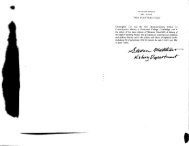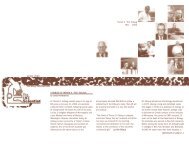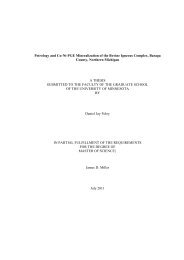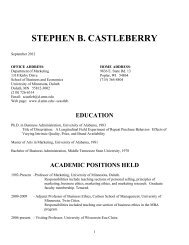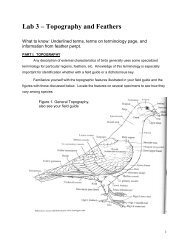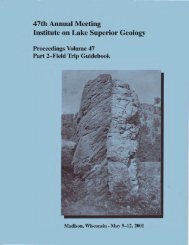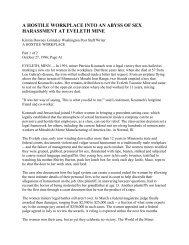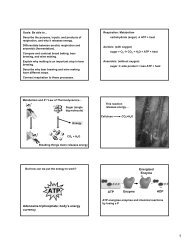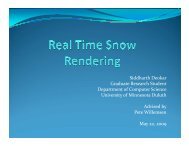Program, Abstracts, and Guidebooks - University of Minnesota Duluth
Program, Abstracts, and Guidebooks - University of Minnesota Duluth
Program, Abstracts, and Guidebooks - University of Minnesota Duluth
Create successful ePaper yourself
Turn your PDF publications into a flip-book with our unique Google optimized e-Paper software.
—47--<br />
WIDESPREAD OCCURRENCE OF ALUMINOUS MINERALS IN APH.EBIAN QUA.RTZITES<br />
GRANT M. YOUNG<br />
Department <strong>of</strong> Geology<br />
<strong>University</strong> <strong>of</strong> Western Ontario<br />
ABSIRACT<br />
After the conclusion <strong>of</strong> the world-wide Kenoran thermo-tectonic events<br />
(Ca. 2.5 b.y. ago) there was development <strong>of</strong> the first extensively preserved<br />
stable shelf assemblages <strong>of</strong> the geological record. Rocks <strong>of</strong> this type<br />
were first studied in Canada in the region north <strong>of</strong> Lake Huron by Murray.<br />
(1849) <strong>and</strong> Logan <strong>and</strong> Sterry Hunt (1855). The Huronian succession includes<br />
several polyrnictic conglomerates which have been interpreted as glacial<br />
deposits. The youngest <strong>of</strong> these conglomerates (Gowg<strong>and</strong>a Formation) is thick<br />
<strong>and</strong> extensive <strong>and</strong> has recently been considered correlative with other<br />
early Proterozoic (Aphebian) tillites in a large area extending from S.E.<br />
Wyoming to the Keewatin District <strong>of</strong> the N.W.T. (Young, in press).<br />
The upper stratitified unit <strong>of</strong> the Gowg<strong>and</strong>a Formation is overlain by<br />
a thick (5-6,000 ft.) quartzite formation (Lorrain) that is also very<br />
extensive. Many different subdivisions <strong>of</strong> this unit have been proposed,<br />
but on a regional scale, a threefold subdivision seems most reasonable.<br />
The lowest subdivision is a varicoloured (red, white <strong>and</strong> green) succession<br />
<strong>of</strong> felspathic grits <strong>and</strong> s<strong>and</strong>stones. This is followed by a unit charac—<br />
tensed by the presence <strong>of</strong> quartz <strong>and</strong> jasper pebble conglomerates <strong>and</strong> the<br />
uppermost unit is an extremely pure orthoquartzite. In many areas the<br />
middle unit <strong>and</strong> the lower.part <strong>of</strong> the upper unit contain aluminous minerals<br />
such as kaolinite, diaspore, pyrophyllite, kyanite <strong>and</strong> <strong>and</strong>alusite (Church,<br />
1967; Ch<strong>and</strong>ler et al., 1969). These minerals are thought to represent<br />
an in situ weathering (bauxitization) process which occurred shortly<br />
after deposition <strong>and</strong> gave rise to kaolinite which wa.s later changed by<br />
further diagenesis <strong>and</strong> metamorphism to the other minerals listed above.<br />
The reasons for invoking this mode <strong>of</strong> origin rather than origin by deposition<br />
<strong>of</strong> "primary" kaolinite at the time <strong>of</strong> sedimentation or by late<br />
post depositional weathering are as follows: -<br />
1. Fresh felspars are abundant in other Huronian outcrops.<br />
2. The kaolinite commonly occurs as "clots" <strong>of</strong> the same order <strong>of</strong><br />
size as the associated quartz grains, suggesting that each clot<br />
represents an altered felspar grain.<br />
3. It is difficult to envisage the conditions under which fine<br />
Jcaolinitic crystals could be sedimented together with coarse<br />
quartz grains (see Ojakangas, 1965, for discussion <strong>of</strong> the same<br />
problem in Jatulian quartzites <strong>of</strong> Finl<strong>and</strong>).<br />
4. In some sections metamorphic minerals may be seen developing<br />
from kaolinite.




